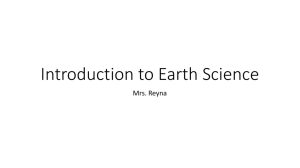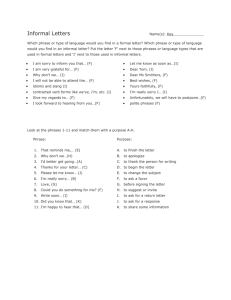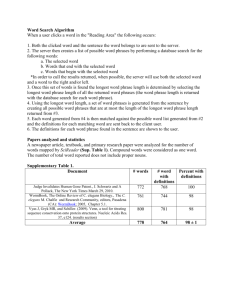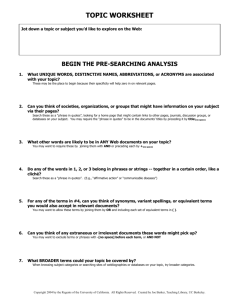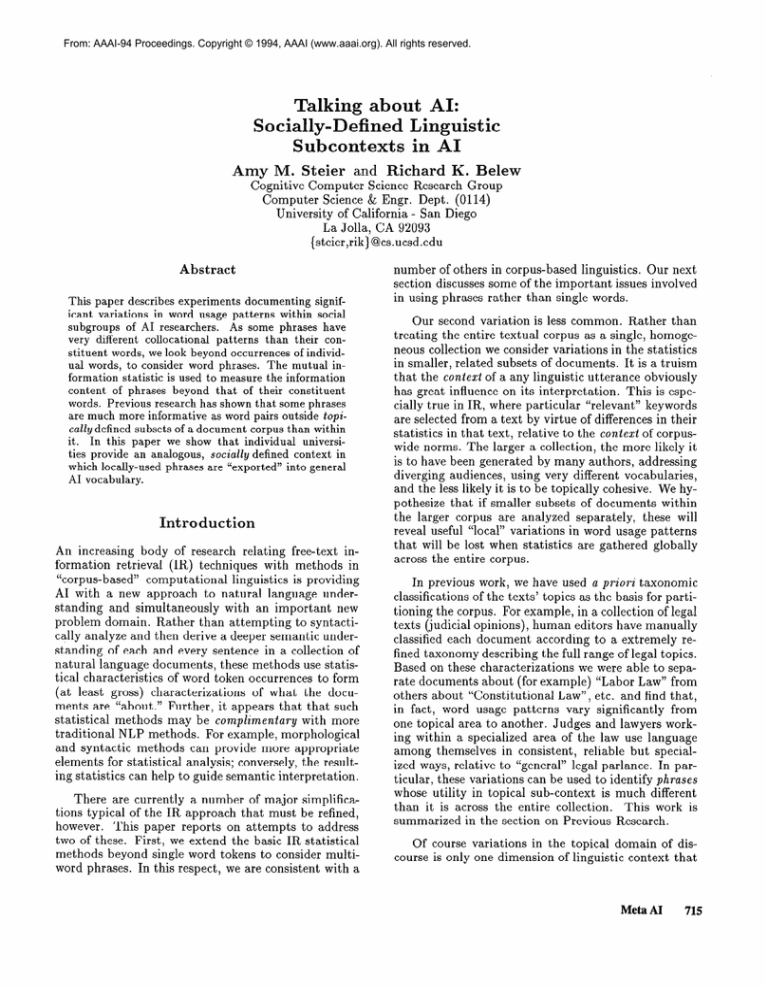
From: AAAI-94 Proceedings. Copyright © 1994, AAAI (www.aaai.org). All rights reserved.
Talking about AI:
Socially-Defined Linguistic
Subcontexts in AI
Amy
M. Steier
and
Richard
K. Belew
Cognitive Computer Science Research Group
Computer Science & Engr. Dept. (0114)
University of California - San Diego
La Jolla, CA 92093
{steier,rik}@cs.ucsd.edu
Abstract
This paper describes experiments
documenting
significant variations
in word usage patterns
within social
subgroups
of AI researchers.
As some phrases have
very different collocational
patterns
than their constituent words, we look beyond occurrences
of individual words, to consider word phrases.
The mutual information
statistic is used to measure the information
content
of phrases beyond that of their constituent
words. Previous research has shown that some phrases
are much more informative
as word pairs outside topicadlydefined subsets of a document corpus than within
it.
In this paper we show that individual
universities provide an analogous,
socicslly defined context in
which locally-used
phrases are “exported” into general
AI vocabulary.
Introduction
An increasing body of research relating free-text information retrieval (IR) techniques with methods in
“corpus-based”
computational
linguistics is providing
AI with a new approach to natural language understanding and simultaneously
with an important new
problem domain. Rather than attempting to syntactically analyze and then derive a deeper semantic understanding of each and every sentence in a collection of
natural language documents, these methods use statistical characteristics of word token occurrences to form
(at least g ross ) c h aracterizations
of what the documents are “about.” Further, it appears that that such
statistical methods may be complimentary
with more
traditional NLP methods. For example, morphological
and syntactic methods can provide more appropriate
elements for statistical analysis; conversely, the resulting statistics can help to guide semantic interpretation.
There are currently a number of major simplifications typical of the IR approach that must be refined,
however. This paper reports on attempts to address
two of these. First, we extend the basic IR statistical
methods beyond single word tokens to consider multiword phrases. In this respect, we are consistent with a
number of others in corpus-based linguistics. Our next
section discusses some of the important issues involved
in using phrases rather than single words.
Our second variation is less common.
Rather than
treating the entire textual corpus as a single, homogeneous collection we consider variations in the statistics
in smaller, related subsets of documents. It is a truism
that the context of a any linguistic utterance obviously
has great influence on its interpretation.
This is especially true in IR, where particular “relevant” keywords
are selected from a text by virtue of differences in their
statistics in that text, relative to the context of corpuswide norms. The larger a collection, the more likely it
is to have been generated by many authors, addressing
diverging audiences, using very different vocabularies,
and the less likely it is to be topically cohesive. We hypothesize that if smaller subsets of documents within
the larger corpus are analyzed separately, these will
reveal useful “local” variations in word usage patterns
that will be lost when statistics are gathered globally
across the entire corpus.
In previous work, we have used a priori taxonomic
classifications of the texts’ topics as the basis for partitioning the corpus. For example, in a collection of legal
texts (judicial opinions), human editors have manually
classified each document according to a extremely refined taxonomy describing the full range of legal topics.
Based on these characterizations
we were able to separate documents about (for example) “Labor Law” from
others about “Constitutional
Law”, etc. and find that,
in fact, word usage patterns vary significantly
from
one topical area to another. Judges and lawyers working within a specialized area of the law use language
among themselves in consistent, reliable but specialized ways, relative to “general” legal parlance. In particular, these variations can be used to identify phrases
whose utility in topical sub-context
is much different
than it is across the entire collection.
This work is
summarized in the section on Previous Research.
Of course variations in the topical domain of discourse is only one dimension of linguistic context that
Meta AI
715
might interest us. In this paper, we attempt to consider
socially defined sub-contexts within the larger context
of artificial intelligence (AI). Using as our corpus a
set of thesis abstracts all nominally about AI, we consider variations in single word and “bigram” (sequential word pairs) statistics arising within the context of
particular universities at which the theses were written. We hypothesize that research groups at universities also define a useful linguistic sub-context.
That is,
they too use language among themselves in consistent,
reliable ways that may not - yet - be shared with the
rest of AI. The details and results of our experiment are
described in the section titled Recent Experiments. We
conclude with comments about relating this sociallydefined notion of context with others.
Phrasal
Semantics
Simple phrases provide an attractive first step beyond
the simple “bag of words” techniques generally associated with IR. Phrases are interesting in part because
of the complex way in which meanings associated with
constituent words are combined to form more elaborate semantic expressions.
D.A. Cruse has defined a
“transparent” expression to be one whose meaning is
derived directly from that of its constituent words; and
“opaque” phrases as those whose semantics cannot be
attributed to the simple composition of its constituent
terms (Cruse 1986). For example, whereas the meaning
of red herring
or red carpet
is opaque, the meaning of red paint is much more transparent.
Halliday
has made similar distinctions between “simple,” “compound” and “phrasal” lexical items (Halliday 1966).
He writes that often a phrase can act very much like
a lexical unit in and of itself, and that often a phrase
can have very different collocational
patterns than the
sum of its parts. From a practical IR perspective, these
linguistic issues become the question of just when indexing word compounds offers advantages over simpler
indexing of individual words.
We follow other recent work that considers a minimalist notion of phrase, based on simple collocation (Maarek & Smadja 1989)(Fagan 1989)(Church
&
Hanks 1990). As we are most interested in simple word
compounds
(such as social
security),
we use “bigrams” (sequential word pairs) to identify potentially
Church and Hanks
interesting word co-occurrences.
have shown that compounds
have a very fixed word
order and that the average separation is one word
(Church & Hanks 1990).
We therefore restrict ourselves to a window of one when parsing for bigrams.
Words have meanings derived from their use both
independent
of, and with respect to, use within a
phrase. Conversely, the phrasal meaning is drawn from
the meaning of the constituents
as well as from the
“use” of the phrase. As a phrase becomes more fre-
716
Meta AI
quently used, we hypothesize that a phrase’s meaning
draws less on the experience of the constituents’ uses
in other contexts and more on the experience of the
phrase in its particular context.
In other words, less
meaning is drawn from the “transparent” semantics of
the constituents, while more meaning becomes related
to the direct experience of using the phrase. Mutual
information therefore becomes a very natural measure
of the disparity between a phrase’s use and the independent use of its constituent words:
MI( 201) w2) = dog
f+ob( w , ~2)
Prob( wl)Prob( 202)
Here, Prob(wi) is the frequency of word wi divided
by the size of the corpus NW and Prob(wi, 202) is the
frequency of bigram (WI, 202) divided by NW.
A41
has often been used to measure lexical cohesiveness or
strength of association between two words (Magerman
& Marcus 1990; Hindle 1990; Church et al. 1991).
Because we will be considering sub-contexts
of a
large corpus, we will compute a phrase’s mutual information with respect to both the entire corpus and
a particular subset of documents.
We will show that
across the difference sub-contexts of a large corpus, the
extent to which a phrase acts like a lexical unit varies,
and in a way: if a phrase has high mutual information
with respect to the entire collection, then it will have a
depressed mutual information value with respect to a
specific context if and only if at least one of the phrase’s
constituent words is independently
very descriptive of
the subcontext.
Previous
Research
This paper is a continuation of earlier research where
we looked beyond occurrences of individual words, to
consider word pairs or phrases (Steier & Belew 1993).
The focus of this earlier research was to study how
the informational
content of phrases, beyond that of
their constituent words, can change within topically
restricted areas. The mutual information measure was
used as the statistic best reflecting this value.
This previous research was performed using a large
collection of judicial opinions,
covering virtually all
topics of U.S. case law, provided by West Publishing Company.
West uses a rich hierarchical indexing
scheme (the Key number system) to topically organize
all case digests. We were thus able to define topical
sub-contexts
within the collection through the use of
this indexing scheme. The headnotes ’ of these cases
were grouped together by topic numbers to get a total
of 339 topical subcontexts.
‘Headnotes
are p recis
capture the central points
generated
by West’s editors
of each judicial opinion.
to
After some simple stemming, 2 all bigrams within
each topical subcontext
were extracted.
Any bigram
crossing punctuation
marks, as well as any bigrams
containing “noise words” from a list of common English
words were not considered.
It is important to note
that our noise word list not only contained non-content
words such as articles and prepositions, but words that
are extremely common in a legal context.
3 Since
the mutual information measure can become unstable
when counts are very low, any bigram occurring less
than three times within a topical subcontext or outside
of it was also filtered.
For each bigram within a topical subcontext,
its
mutual information
(cf.
Phrasal Semantics section)
with respect to the subcontext, A&l,, as well as a value
with respect to the entire collection &!I, was computed.
In computing
MI,,
NW is the total number
of words in the entire collection.
In computing AJ1,,
NW is the number of words in that particular topic
area. The consequence of this measure is if the constituents of a phrase occur together much more often
than chance, the phrase will have a high mutual information value. The higher the mutual information
value is between a pair of words, the more informative that pair is as a phrase. It is not that the phrase
is necessarily more contentful but that our interpretation of the phrase is less easily derived from the typical
meaning associated with its constituents.
Next, each individual word within a topic area was
given an index term weight based on a variant of the
term frequency x inverse document frequency weighting scheme devised by Salton and Buckley 4 (Salton
& Buckley 1988). If Fij represents the frequency of
term j in document i, DFj, the document frequency
of term j, ND, the total number of documents,
and
Ni, the number of words in document i, then TWij,
the term weight of term j in document i, is given by
the following formula:
TWij
Fij
=
cf:,
X
lOg(ND/DFj)
(Fint x log( ND /Dr;;c)>2
In studying how the mutual information of bigrams
changes across different subcontexts,
our most central finding was that a decrease in mutual information
within a topic area turns out to by highly correlated to
the maximum of the term weights associated with the
bigrams constituents.
In other words, bigrams with
high informational
content across the entire collection
have depressed informational
content (i.e. convey less
20ur stemming consisted only of converting aJl plural
nouns to their singular form.
3An example of this would be legal abbreviations of
statute sections.
4This term weighting
widely used in I.R.
technique
is currently
the most
PHRASE
TWM
MINIMUM WAGE
WORKER COMPENSATION
COLLECTIVE
BARGAINING
UNION MEMBER
OCCUPATIONAL
OVERTIME
SAFETY
PAY
LOCAL UNION
PENSION
PLAN
LABOR RELATION
LABOR STANDARD
,057
.043
.185
.449
.050
.062
.449
.076
.495
.495
MIt
9.48
5.98
7.80
6.31
10.51
5.40
6.03
8.42
4.99
5.78
Table 1: Example phrases where the mutual information within the collection (Ml,)
exceeds that within
the topic Labor Relations (M1t.)
information)
- as bigrams - within their semantically
related topical area if, and only if the bigram’s constituents are good descriptors of that topic area.
Table 1 shows some examples where M1, exceeds
MITt for the topic Labor Relations. In studying these
phrases, what stands out is how apropos to the Labor Relations topic the phrases in Table 1 are. TWM
(maximum term weight) is the larger of the two term
weights associated with the phrases constituents with
respect to the topic Labor Relations. All term weights
range between 0 and 1, and the median term weight
for a topic is about .03. There is a strong tendency for
phrases with high TWM to have a depressed mutual
information
value within the topic.
The correlation
between TWM and difference in MI (A&It - Ic12T,) in
the Labor Relations topic was -.62. This was found to
be very typical across the other topics within the collection. This correlation has also been independently
reported by Damerau (Damerau 1993).
The conclusion
we draw from this phenomenon
is that the more descriptive
the constituents
of a
phrase are with respect to a specific topic, the more
transparent that phrase is within the topic and the
more opaque it is outside the topic.
Take, for example, the phrase PENSION PLAN. This phrase seems
to be much more opaque (i.e.
have a much higher
phrasal information
content)
across the entire collection.
Yet within the Labor Relations topic, the
constituents PENSION and PLAN are very descriptive
of the central issues.
Not only do these words occur together as PENSION PLAN, but they often occur
separately (e.g., PENSION FUND, PENSION BENEFIT,
PENSION
BOARD,
INSURANCE
PLAN,
WELFARE
PLAN.)
Our interpretation
of these results was that technical phrases are often “deconstructed”
into their constituents within a particular topical sublanguage.
The
semantic
nuances
that are explored in detail within a
topical area are then left behind as this phrase is “exported” into general vocabulary, where dominant use
Meta AI
717
of the constituent words are as part of the phrase. Further, we found evidence of an intriguing “self-similar”
When we reregularity in this exporting
relation.
peated the experiments
using a topic subcontext
as
the “collection”,
and that topic’s different sub-topics
as the different subcontexts,
we again found this exporting phenomenon
to exist. This led us to conclude
that “opacity” is a relative concept. An opaque phrase
whose meaning appears to have little relation to that of
its constituent words may in fact be transparent within
some restricted sublanguage,
perhaps associated with
its genesis. Of course, this sublanguage may no longer
exist, or it may simply require closer analysis of restricted portions of the general textual corpus.
Recent
To begin our experiments, the noise word list is first
updated to include terms that are extremely common
in the context of AI. A noise term is a low information
word or phrase within a particular context. In Information Theory, the information encoded in a symbol is
relative to the uncertainty associated with that symbol occurring.
In language, very frequent words (or
phrases) provide us with little information.
Less frequent words provide us with more information.
To
put it another way, information
is a deviation from
what you expect. It is a common practice within IR to
maintain a “negative dictionary” of frequently occurring “noise words” in any language.
When a textual corpus is further restricted to a particular topic, additional words also become effectively
noise.
For example, in a collection of computer industry magazine articles, the word COMPUTER becomes
almost (statistically)
meaningless.
It is therefore appropriate to augment the standard negative dictionary
with those additional words that are effectively noise in
a particular corpus. The top noise words with respect
to our AI collection are listed in Table 2.
all bigrams
from each of university
subcon-
5Total number of words in our collection is 535804.
718
Meta AI
WORD
I TFC I
SYSTEM
MODEL
PROBLEM
KNOWLEDGE
NETWORK
EXPERT
DESIGN
PROCESS
USED
APPROACH
METHOD
LEARNING
USING
ALGORITHM
CONTROL
WORD
6991 BASED
3328
2754
2734
2267
2062
2046
1815
1693
1652
1605
1527
1501
1480
1394
l--T
1 rc
TECHNIQUE
DATA
RESEARCH
USE
INFORMATION
NEURAL
DEVELOPED
RESULT
ANALYSIS
TWO
NEW
COMPUTER
APPLICATION
PERFORMANCE
1357
1319
1319
1293
1257
1253
1231
1188
1175
1130
1049
1013
982
979
963
Table 2: Top noise words in our AI collection.
the term frequency within the collection.
Experiments
The textual corpus used in our current is a set of masters and Ph.D. thesis dissertations, collected via questionaires but especially from the University Microfilms
database during the past 5 years. Title and abstract
text for each of these approx.
2600 theses was combined, with each thesis comprising approx. 2000 bytes.
5 It is important to recognize that while this corpus
is of obvious interest, it is very small by IR standards
and we have had to tailor many of our statistics somewhat in order to handle the very small sample sizes
involved. Subsets of the corpus were formed for each
of the 100 universities most well-represented in the collection. This ranged from Stanford with 79 theses to
Yale with only seven.
Next,
I
TF,
is
PHRASE
TFc
1456
EXPERT SYSTEM
NEURAL NETWORK
1075
ARTIFICIALINTELLIGENCE
632
KNOWLEDGEBASE
394
PROBLEM SOLVING
247
ARTIFICIALNEURAL
175
KNOWLEDGE-BASEDSYSTEM
160
KNOWLEDGEACQUISITION
159
CONTROL SYSTEM
158
KNOWLEDGEREPRESENTATION 154
LEARNINGALGORITHM
145
144
DECISIONSUPPORT
NATURAL LANGUAGE
142
DECISIONMAKING
131
PATTERN RECOGNITION
126
SUPPORT SYSTEM
124
MACHINE LEARNING
120
DISSERTATIONPRESENT
103
DESIGN PROCESS
102
Table 3: Most frequent phrases in our AI collection.
TF, is the term frequency within the collection.
texts are extracted. Any bigram that contains a noise
word or occurs more than 100 times in the collection
is discarded. These very frequently occurring phrases
are also effectively “noise” when computing collection
statistics.
These phrases are listed in Table 3. Note
how much more contentful these phrases are than the
single words. This additional specificity in meaning is
the central reason why phrases are being used more
and more in document indexing.
A mutual information value is computed with respect to each university subcontext,
MI,,
as well as
with respect to the entire collection, MI,.
Each individual word within a subcontext is assigned an index
term weight, using the term weighting formula mentioned earlier.
Our analysis is then to study how the mutual information
(MI)
of phrases changes within the individual university subcontexts.
As in our previous experiments,
we look at the correlation between
the maximum term weight of a phrase’s constituents
and the difference in collection
and university MI
(J&1, - MI,).
Once again, we find the “export” relation to exist. The average correlation between difference in MI and maximum term weight is -.61 within
the individual university subcontexts.
Figure 1 shows this relationship for all university
subcontexts
combined.
Since our term weighting algorithm assigns to the majority of terms a very low
weight, and then progressively less terms a higher and
higher weight, we use the log of the maximum term
weight to more aptly show its relationship to the difference in mutual information.
The correlation of the
two parameters in this graph is -.61.
respect to a specific university’s AI thesis research, the
more transparent that phrase is within that university’s context and the more opaque it is outside that
context.
Take, for example, the phrase CASE-BASED
REASONING. This phrase seems to be very opaque (i.e.
have a high mutual information value) across the entire
context of AI. Yet within the a few of the individual
university subcontexts (e.g. Yale, Georgia Tech. and
the University of Massachusetts)
the phrase’s meaning is much more transparent. Within these particular
subcontexts, the terms CASE-BASED and REASONING are
highly weighted as being descriptive of their AI thesis research. The constituent concepts of CASE-BASED
and REASONING are examined in detail and independently.
Not only do these words occur together as
CASE-BASED
REASONING, but they often occur separately (e.g.
CASE-BASED
PLANNING,
CASE-BASED
ARGUHENT,
REASONING,
CASE-BASED
ANALOGICAL
PROBLEM,
SCHEMA-BASED
REASONING,
COMMONSENSE
As this phrase is “exported” into the general AI vocabulary, the semantic nuances are left behind, and the dominant use of the constituent words is
as part of the phrase.
REASONING).
CD
*
.-.,.
*
--..
L.
i
d -
*
-.
*
*
X._
...
**
**
*
Conclusion
**
7
2 N.-C
$ 0 5
&
s=
n cu***
P -
*
_
l
*
**
*
I
0.001
I
I
I
I
I
I
0.005
Maximum Term Weight
Figure 1: Log of the Maximum Term Weight to differf or all university subcontexts.
ence in MI (MI, --MI,)
The dotted line in the graph maps the least squared
fit.
Table 4 lists example bigrams which exhibit the export relation. The 35 universities from which examples
are taken are those with the highest number of AI theses associated with them.
The conclusion we draw from this analysis, is that
individual universities do indeed represent distinct linguistic subcontexts.
More specifically, we find that the
more descriptive the constituents of a phrase are with
In studying the phrases that exhibit the export relation, we find occasional instances where the same
phrases is exported from different universities. For example, the phrase CASE-BASED REASONING is shown to
be an export phrase from the universities of Yale, GeorIt is
gia Tech. and the University of Massachusetts.
interesting to note that some of the students Schank
advised at Yale, graduated and then took on teaching
positions at both Georgia Tech.
and the University
of Massachusetts.
We hypothesize that this type of
AI lineage (or genealogy) information might be used to
create yet another socially-defined
set of linguistic subcontexts. We are currently in the process of gathering
this type of AI genealogy information.
We interpret the export phenomena of important
word combinations
as a migration, from a context in
which the nuances of each words’ meaning is considered independently out into a broader context in which
only the central and now “opaque” interpretation
of
the phrase is useful. If true, there must be a time delay to this progression, and a particular textual corpus
may or may not capture it. In our previous experiments with legal texts, the opinions cover a very long
time period, with ample opportunity for technical jargon (e.g., PENSION PLAN or SOCIAL SECURITY)to
migrate from use by a restricted group of specialists to
lawyers and judges generally.
It is somewhat curious, then, that even in the
very short five-year window spanned by our AI theses
should be sufficient time to also give evidence of phrase
Meta AI
719
STANFORD
BELIEF
REVISION
INFLUENCE
DIAGRAM
NONMONO.
REAS.
UNIV.
ILL. (URB-CHAMP)
MASSIVELY
PARALLEL
PURDUE
COLLISION-FREE
PATH
MATERIAL
HANDLING
MOBILE ROBOT
UNIV.
TEXAS
(AUSTIN)
INFLUENCE
DIAGRAM
TEXT UNDERSTANDING
CARNEGIE-MELLON
CHESS PROGRAM
ABSTRACTION
HIER.
MOBILE ROBOT
OHIO STATE
MALF. DIAGNOSIS
CREDIT
ASSIGNMENT
UNIV.
CALIF.
(BERK.)
SEMICOND.
MANUF.
TOOL WEAR
FUZZY LOGIC
TEXAS
A&M
OBSTACLE
AVOIDANCE
CIRCUIT
BOARD
Table 4:
collection
UNIV.
MASSACHUSETTS
PLAN RECOGNITION
ROBOT ARM
CASE-BASED
REAS.
UNIV.MARYLAND
HIDDEN
UNIT
LOAD BALANCING
GRADIENT
DESCENT
COUN.
NAT. ACA. AWRDS
SPEECH
RECOGNITION
COLLISION
AVOIDANCE
FLEXIBLE
MANUF.
UNIV.
MINNESOTA
ASSOCIATIVE
MEMORY
ANALOGICAL
REAS.
UNIV.
MICHIGAN
BODY MOTION
RIGID BODY
DOCUMENT
RETR.
NORTHWESTERN
DEDUCTIVE
DATABASE
THEOREM
PROVER
ARIZONA
STATE
SYSTOLIC
ARRAY
LOAD FORECASTING
LP FORMULATION
ILLINOIS
INST. TECH.
INTELL.
TUTORING
UNIV.
MISSOURI
(ROLLA)
DEVELOPING
COUNTRY
IMAGE SEGMENTATION
UNIV.
CINCINNATI
LP FORMULATION
MOMENT
INVARIANT
N.C. STATE
(RALEIGH)
SIMULATED
ANNEALING
IMAGE SEGMENTATION
CONSTRAINT
SATISF.
UNIV.
COLORADO
(BOULDER)
RIVER BASIN
BIOLOGICAL
NERVOUS
UNIV.
CALIF.
(LOS ANGELES)
NUCLEAR
REACTOR
FAULT TOLERANCE
RUTGERS
(NEW
BRUNSWICK)
DEDUCTIVE
DATABASE
UNIV.
WASHINGTON
STATE-SPACE
SEARCH
MULTI-LAYER
PERC.
STEADY
STATE
MIT
TOOL WEAR
LIMIT CYCLE
THESIS
PRESENT
YALE
INTENTIONAL
STATE
CASE-BASED
REAS.
Example bigrams where the mutual information in the university file (n/rru) exceeds
(Mlc).
U niversities are listed in order of number of AI theses associated with them.
exporting.
Our explanation is that this is due to the
speed with which technical, scientific language adapts,
relative to more common forms. It does not seem unreasonable that through conference and journal papers, let alone “directly” through influential theses,
language used successfully within one research group
(e.g.,
CASE-BASED
REASONING) can come to influence
the AI community
generally in just a few years. If
true, it suggests that scientific (and other professional)
communication
might provide an especially illuminating perspective into fundamental properties of linguistic evolution.
Church, K., and Hanks, P. 1990. Word association
norms, mutual information and lexicography.
Computational Linguistics 16( 1).
Church, K.; Gale, W.; Hanks, P.; and Hindle, D.
1991. Using Statistics in Lexical Analysis. New Jersey
and London: Lawrence Erlbaum Assoc. 115-164.
Cruse, D. 1986. Lexical Semantics.
bridge University Press.
New York:
Cam-
Damerau, F. J. 1993.
Generating and evaluating
domain-oriented
multi-word terms from texts. Information Processing and Management
29(4):433-447.
Meta AI
that within
the
Fagan, J. 1989. The effectiveness of a nonsyntactic
approach to automatic phrase indexing for document
Society for Inforretrieval. Journal of the American
mation Science 40(2):115-132.
Halliday, M. 1966.
don: Longmans.
Lexis as a Linguistic
Level.
Lon-
Hindle, D. 1990. Noun classification from predicateargument structures. In 28th Annual Meeting of the
Association for Computational
Linguistics.
Maarek, Y., and Smadja, F. 1989. Full text indexing
based on lexical relations. In Proceedings of the 12th
International
Conference
on Research and Development in Information
Retrieval.
Magerman, D., and Marcus, M. 1990. Parsing a natural language using mutual information statistics. In
Proceedings of AAAI ‘90.
References
720
UNIV.
PENNSYLVANIA
HORN CLAUSE
END EFFECTOR
PENN.
STATE
ARC WELDING
MOMENT
INVARIANT
GARBAGE
COLL.
UNIV.
WISC.
(MADISON)
ARC WELDING
WELDING
ROBOT
UNIV.
FLORIDA
OBJ.-ORIENTED
D.B.
D.B. MANAGEMENT
UNIV.
ARIZONA
EQUILIBRIUM
POINT
UNIV.
PITTSBURGH
NONE
CASE WESTERN
OBJECT
RECOGNITION
UNIV.
TEXAS
(ARLING.)
BUILDING
BLOCK
RENSSELAER
POLY.
INST.
ROBOTIC
ASSEMBLY
ERROR RECOVERY
GEORGIA
TECH.
SENSOR
FUSION
CASE-BASED
REAS.
Salton, G., and Buckley, C. 1988. Term-weighting
approaches in automatic text retrieval. Information
Processing and Management
24(5):513-523.
Steier, A., and Belew, R. 1993. Exporting phrases:
A statistical analysis of topical language. In Second
Annual Symposium on Document Analysis and Information Retrieval.


